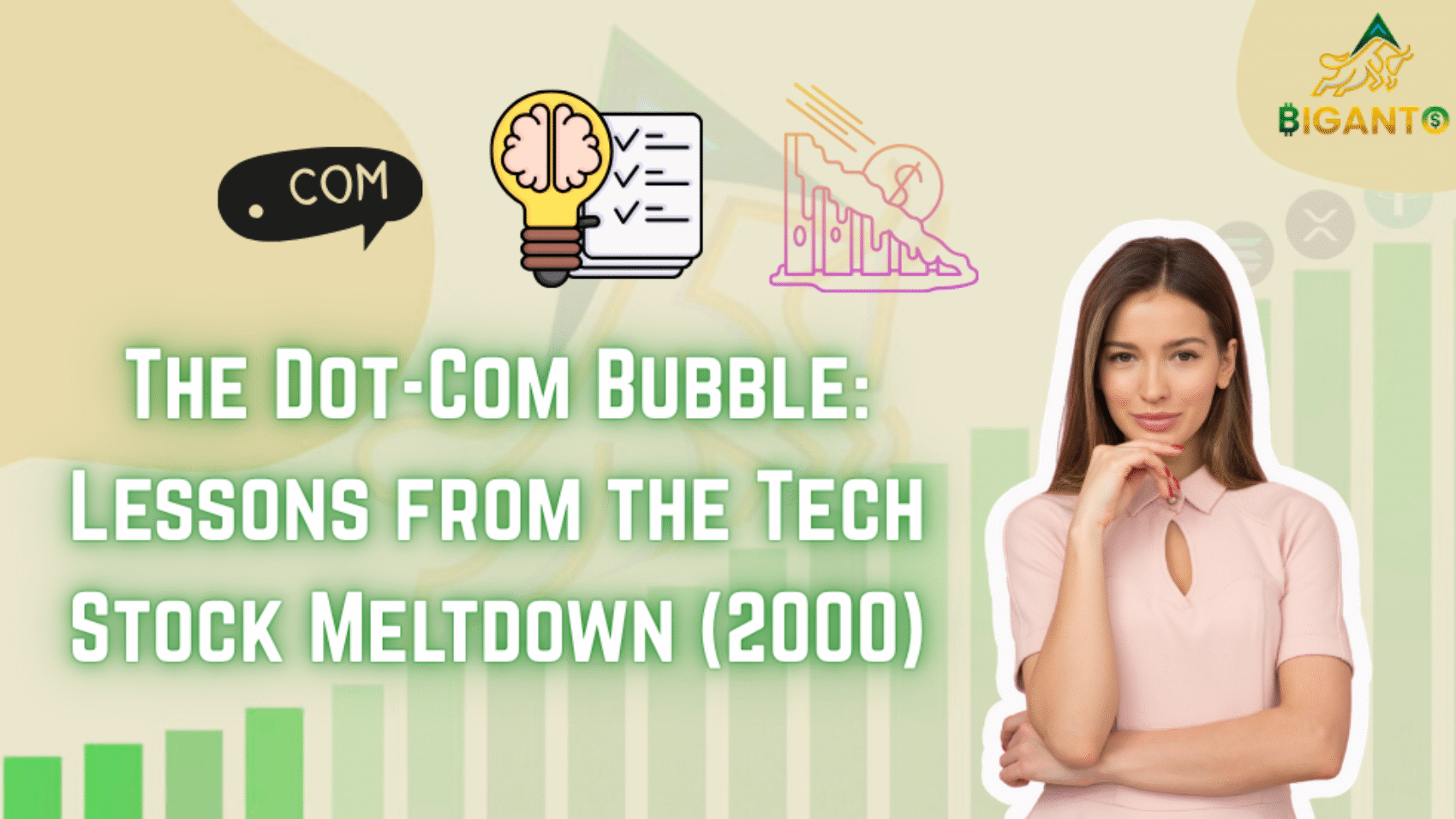Introduction
The Dot-Com Bubble was a tech-driven craze that swept the world at the turn of the millennium. Internet-based businesses, which frequently had little more than a domain name, enjoyed a sharp increase in worth between the late 1990s and the early 2000s. Billions of dollars poured into firms with uncertain business plans and no obvious route to success, driven by growing internet penetration, media excitement, and investor FOMO.
When this bubble burst, it destroyed trillions of dollars’ worth of market value and revealed the perils of unbridled speculation, symbolizing the optimism of the digital age. In addition to changing the startup ecosystem, the crash left behind important lessons that are still applicable today.
The Dot-Com Bubble: What Was It?
Dot-Com The late 1990s and early 2000s were known as the “bubble,” a time of tremendous expansion and speculation in businesses connected to the internet. Because they thought they were the business of the future, investors flocked to businesses with “.com” in their names as the internet became more widely used.
Despite frequently having no actual income, earnings, or even a workable business plan, the stock prices of these tech companies skyrocketed. Traditional measures like P/E ratios were disregarded because of the fervor of the hype. Despite having little to offer, several of the companies that went public (IPO) were valued in the billions.
The bubble burst in 2000, when it became clear that many of these businesses were unsustainable. This led to a massive crash, especially in the NASDAQ index, wiping out trillions of dollars and closing down hundreds of startups.
In short, the Dot-Com Bubble was a classic case of irrational market exuberance, where the dream of the internet overtook financial reality.
The Rise of the Bubble (1995-2000)
The tremendous growth of internet-based businesses, or “dot-coms,” occurred in the second half of the 1990s. A promising wave of digital innovation soon turned into a full-fledged speculative frenzy. The following significant factors led to this historic bubble:
1. The Internet Gains Popularity
The number of people online increased significantly as a result of the World Wide Web’s widespread acceptance, as well as more access to personal computers and dial-up connections. Excitement about the internet’s commercial possibilities was sparked by this abrupt increase in connectivity, which created the foundation for whole new digital business models.
2. Everyone Wanted to Join IPO Mania
Tech companies hurried to go public during the bubble’s height, frequently within a year or two after their founding. Initial Public Offerings (IPOs) have turned into media spectacles, with firms like eToys and Pets.com soaring to enormous valuations at launch while having no obvious route to profitability. Due to the extreme excitement, investors purchased shares solely on the basis of hype, anticipating a sharp increase in value on Day 1.
3. Momentum Driven by Hype
A important factor in stoking the fires was the media. Newspapers, tech publications, and business channels were replete with tales of internet firms making their founders instant millionaires. Retail investors felt a sense of urgency as a result of this ongoing publicity, since they were afraid of falling behind—a typical case of FOMO.
4. Absence of supervision and regulation
The 1990s had a somewhat lax regulatory framework with relation to online enterprises. There was little financial accountability or transparency in the operations of many dot-coms. Up until the bubble burst, accounting errors, exaggerated estimates, and deceptive investment pitches were mostly ignored.
5. Growth at Any Cost
The dominant startup philosophy of the time was “get big fast.” Rather than building sustainable business models, many dot-coms spent heavily on marketing, office space, and hiring to capture market share. Profitability was often considered irrelevant in the short term, as long as growth and user acquisition metrics impressed.
6. Business America Joins the Celebration
by starting their own online divisions or purchasing smaller internet companies, even established organizations began to follow the dot-com trend. As traditional businesses fought to demonstrate that they were adjusting to the “new economy,” this gave the appearance of legitimacy and fueled the bubble.
7. Quick Deals, Easy Money
During this time, venture financing was freely available. Investors were keen to fund anything with a “.com” in its name because interest rates were comparatively low and the stock market was booming. With just a pitch deck and a concept, some firms were able to raise millions of dollars. Angel and venture capitalists’ risk tolerance reached previously unheard-of heights.
Businesses that attracted significant investments while having poor financials and eventually collapsing, such as Pets.com, Webvan, and eToys.com, came to represent this era. With a significant tech stock weight, the Nasdaq Composite Index surged from less than 1,000 in 1995 to a high of 5,048.62 on March 10, 2000.
Dot-Com Meltdown The 2000–2002
What started out as an era of unbridled hope soon descended into one of the most spectacular financial meltdowns in history. Early in the new millennium, the dot-com bubble started to show signs of weakness, and during the course of the following two years, the entire network of inflated internet firms fell apart.
1. When Exuberance Collided with Real Life
Investors began to realize by March 2000 that many online businesses lacked a clear route to success. A sobering revelation replaced the fixation on “eyeballs,” user data, and expansion at all costs: the majority of these businesses lacked a viable business plan. Now that the dream was over, doubt started to grow.
2. IPO Dumping Was Caused by Lock-Up Expirations
Due to “lock-up” periods, which usually lasted six months, many insiders and early investors were prohibited from selling shares right once following first public offerings. Following their expiration, the market was inundated with insider selling, which further stoked investor concern by indicating insiders’ lack of faith.
3. Job Losses and Tech Layoffs Increased
Massive layoffs became commonplace as big tech companies restructured and startups failed. Silicon Valley and other tech centers lost hundreds of thousands of jobs. The image of the opulent, rapidly expanding startup was replaced with pink slips and empty offices, which had an impact on the overall economy.
4. Even the Giants Took a Hit
The crash didn’t just affect speculative startups. Established technology companies like Cisco, Intel, and Oracle saw their stock prices nosedive by over 80%. While these firms had real products and revenues, their valuations had been caught up in the broader tech euphoria and fell sharply as the market corrected.
5. Burning Cash, Burning Out
Most dot-com startups were running on borrowed time—and borrowed money. Their business models were built on rapid spending with no profits in sight. When funding dried up, these companies couldn’t survive. High-profile casualties like Pets.com, Webvan, and eToys became symbols of dot-com excess, shutting down within months of their IPOs despite massive initial hype.
6. Increased Regulatory Examination
Regulatory agencies like the SEC started closely examining how tech companies reported results and conducted initial public offerings (IPOs) after the incident. The catastrophe sparked a larger movement for openness that would eventually impact legislation like the Sarbanes-Oxley Act of 2002, which sought to rebuild investor trust.
7. Tech Media’s Decline Darlings
Media organizations with a tech concentration that had expanded quickly during the boom also suffered. Since their revenue (mostly from dot-com ad spending) dried up, several were forced to close or reduce staff. Their financial backers vanished, and the hype cycle they helped create turned against them.
Lessons from the Dot-Com Collapse: What the Tech Meltdown Taught Us
Dot-Com Collapse Lessons: What We Learned from the Tech Meltdown
More than just a financial catastrophe, the dot-com bubble burst, serving as a wake-up call for legislators, business owners, and investors. It changed the way that markets perceive value, risk, and innovation. The following are the lessons that have stood the test of time:
1. Fundamentals Cannot Be Replaced by Hype
Regardless of how good the technology is, sound business plans, genuine income streams, and a clear route to profitability are necessary for long-term success. In the near term, metrics like “user growth” and “eyeballs” might seem exciting, but they are nothing more than smoke and mirrors without monetization.
2. Reality Must Be Reflected in Valuations
Reasonable appraisal is important. Instead of being evaluated on the basis of excitement, optimism, or the “next big thing” narrative, companies should be evaluated on the basis of their inherent value and projected earnings. In a bull market, overpaying frequently results in unpleasant corrections later.
3. Steer clear of the ‘Greater Fool’ trick
It’s risky to bet that someone else will purchase an overvalued asset at a greater cost. This “Greater Fool Theory” is what causes bubbles, which in turn lead to crashes. Investing need to be based on value rather than conjecture.
4. Consider the Big Picture, Not Just the Next Quarter
It frequently takes time for technological revolutions to develop. The majority of businesses overpromised and underdelivered in the short term, despite the fact that the internet was genuinely revolutionary. As was the case with Amazon, investors who were patient and had a long-term outlook finally benefited.
5. Survivors Were Not Fortunate, But Strategic
Businesses that survived the crash had strong foundations, so they weren’t merely lucky. Companies like Google, Amazon, and eBay prioritized flexibility, execution, and clear market positioning. When others pursued vanity metrics, they changed course, saved money, and created enduring value.
6. Markets Are Protected by Strong Oversight
The collapse made clear the necessity of more robust accounting standards, investor protection, and initial public offerings (IPO) regulatory frameworks. Reforms like the Sarbanes-Oxley Act, which increased corporate accountability and openness, were the result of it.
7. Don’t rely solely on one trend
No matter how hot a sector is, concentrated betting on it might leave your portfolio at risk. In order to guard against volatility and sector-specific downturns, diversity across industries, asset classes, and geographical areas is crucial, as demonstrated by the dot-com bust.
Final Thoughts: From Hype to Hard Lessons
The Dot-Com Bubble was a landmark moment in tech and financial history—one that showcased both the promise and peril of unchecked speculation. While it began with groundbreaking innovation and investor excitement, it quickly spiraled into a frenzy driven by hype, unrealistic valuations, and weak fundamentals.
Its collapse erased trillions in market value and shuttered hundreds of startups, but it also sparked a critical shift in how businesses are built and valued. The companies that survived—like Amazon and Google—did so not by chasing hype, but by focusing on strategy, adaptability, and long-term value. More than two decades later, the lessons from that meltdown remain highly relevant. In today’s fast-moving tech landscape, the Dot-Com era reminds us that sustainable success comes from fundamentals, not frenzy—and that true innovation takes time, discipline, and vision.

